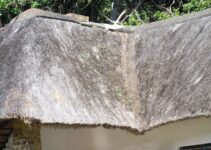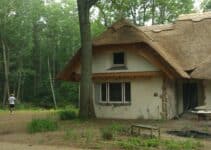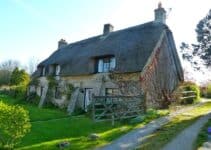When you look at a thatched roof, it’s understandable to question whether it’s actually that warm. After all, it’s some straw on top of a building, right? Well, in this article, we’ll aim to answer the question, are thatched roofs warm?
Along with this, we’ll look at their insulation properties and dig into a bit of the science of how a thatched roof works in terms of heat regulation. By the end, you should know everything you need about thatched roofs and insulation.
But Are Thatched Roofs Warm? Thatched roofs are surprisingly warm and actually offer much greater heat protection than other roofing materials, such as tiles. Although the thatching material doesn’t offer much warmth to the roof, it’s more about what’s between the reeds or straw: air.
Air is a very poor conductor of heat. Simply put, heat transfers through a substance by making its molecules vibrate, which passes on the heat energy.
In air, the molecules aren’t in continuous contact, meaning it’s very difficult to transfer energy between them.
In a thatched roof, the material traps pockets of air, which prevents heat from transferring between the inside and outside of the building.
As such, they work to keep the house warm in the winter and cool in the summer, depending on where the heat is coming from.
Is a Thatched Roof a Good Insulator?
A thatched roof is a pretty good insulator thanks to all the pockets of air trapped in the material. Better yet, the thatching material itself is mostly air, too. For example, straw is a hollow tube that basically acts as another air pocket.
According to Historic England, the minimum standard for an insulated roof is 0.18 W/m2 – its U-value.
This is the rate at which heat energy is lost through 1 metre square of a roof, measured in watts per degree of temperature difference. It’s not massively important to understand what all of this means providing you know what the minimum standard is.
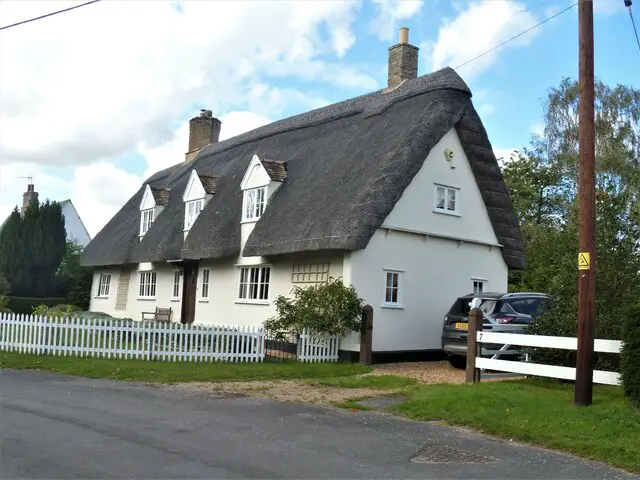
Thatching material can have a U-vale of between 0.23 and 0.29 W/m2. As you can see, this is high enough above the minimum standard for it to still be considered an effective thermal insulator, even by modern standards.
Of course, thatching science has changed in the modern era, but the basic principles remain the same as ever.
These values depend on numerous factors, some of which are beyond our control. That said, we can influence the following variables to improve the insulation properties of a thatched roof:
Pitch
A roof’s pitch is basically how steep it is. It can directly impact the warmth of a thatched roof based on how the air pockets interact with the rising heat.
However, it can have an indirect impact on the roof’s insulation because it affects what you can do with the roof and attic space.
Thickness
Unsurprisingly, the thickness of the thatch will also affect its thermal insulation. As mentioned elsewhere, a thatched roof is usually between 2 and 4 inches thick.
The thickness depends on several factors, but the biggest is the type of material used.
It should come as no surprise that a thicker roof will insulate more effectively. It contains more air pockets than a thinner roof, meaning there’s more space for the heat to travel through.
Of course, you don’t need as much extra insulation on a thicker roof, if you choose to use any at all.
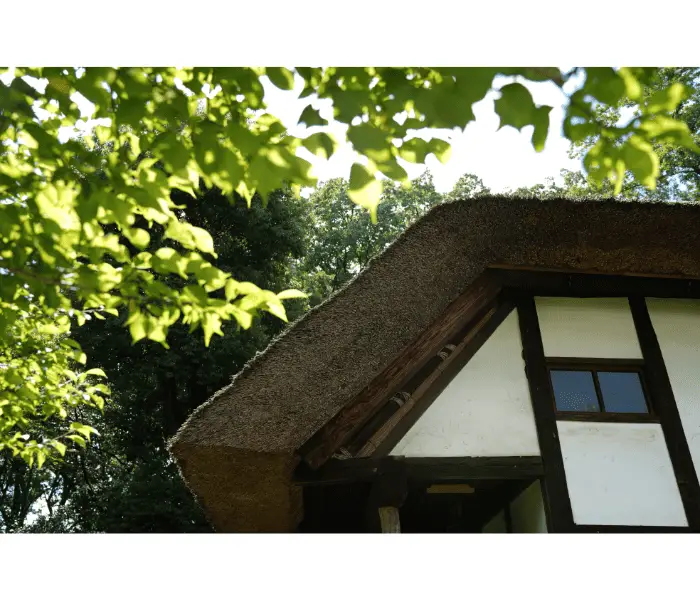
Insulation
A thatched roof can either be a hot or cold roof. A hot roof has insulation under the roof itself, whereas a cold roof has it attached to the ceiling of the top-floor rooms.
In short, a cold roof is considered unhabitable, while a hot roof would technically be habitable.
There’s not necessarily any benefit one way or the other. It’s entirely feasible to use either insulation method on a thatched roof, although a cold roof is generally less expensive.
Also, a cold roof will be easier to install and you won’t have the worry about air infiltration. On a tile roof, it’s much easier to seal air gaps that could lead to heat loss.
Of course, this is more difficult on a thatched roof, as you have fewer solid materials to make joins between. As such, a cold roof is a more widely accepted form of insulation, simply because it’s easier to use.
Traditional materials include everything from hessian sacking to wood shavings. You can use more modern materials, such as polystyrene, which has thermal properties very similar to the thatching material.
However, most synthetic materials are impermeable to moisture, which might sound like a good thing but can have a negative effect on the roof thanks to a lack of ventilation.
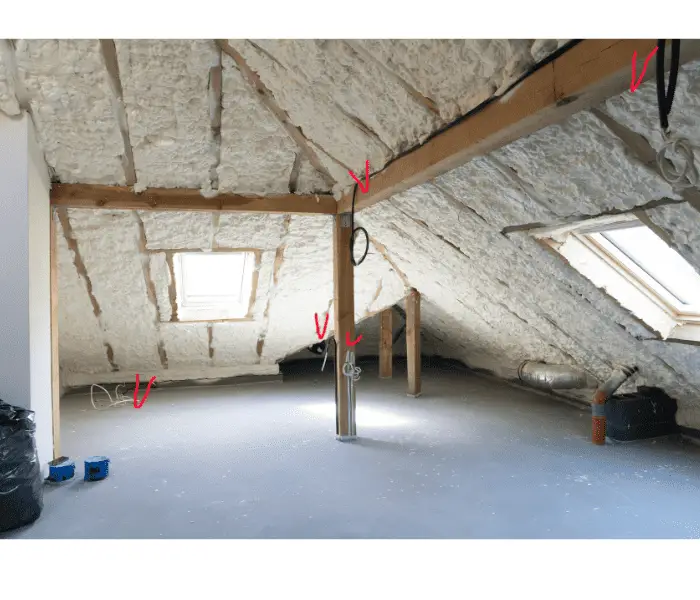
Thatched Roof Ventilation
However, one of the more important factors to consider when thinking about insulation is ventilation. Warm air entering the roof cavity can quickly turn into condensation if it interacts with cooler air.
This isn’t ideal for any roof, but it can be particularly problematic when your roof is made of straw.
Condensation can quickly lead to mould and rot from the inside of your thatched roof out.
The thatch itself is breathable but the rate at which it can lose moisture typically won’t keep up with the amount generated by a family living in the building.
This sort of thing only became an issue with the invention of modern insulation, though. Historically, air gaps between the building and the thatched roof would be blocked with permeable materials, such as straw or clay.
These materials prevented heat loss but allowed moisture to escape when needed. While they’re not as energy-efficient as modern insulation, they at least let the house breathe.
And, if you’ve ever lived in an old building with modern insulation, you’ll know what it looks like when this can’t happen.
Luckily, vapour permeable insulation now exists. This prevents heat from escaping but lets water vapour pass through to keep everything dry.
You’d only need to use this in a warm roof, as a cold roof shouldn’t have much water vapour in it. As mentioned, the thatching material itself can breathe fine, so doesn’t need much ventilation.
Pros and Cons of Thatched Roof for Insulation
Thatched roofs have plenty of benefits from an insulation perspective, but they also have drawbacks. Let’s look at the pros and cons of thatched roofs and their ability to keep the house warm.
Pros
1. They don’t always need extra insulation
As mentioned, a thatched roof with no extra insulation is above the minimum standard required by British law. This might not seem like a big advantage, but it is if you’ve ever seen the amount of insulation needed in a tile roof.
By extension, though, it means you can create an incredibly well-insulated thatched roof with a bit of clever insulation placement.
2. They also provide acoustic insulation
If you know anything about thermal and acoustic transfer, you’ll know they’re fairly similar concepts. As such, it should come as no surprise that a thatched roof provides pretty excellent acoustic insulation.
This might not be particularly useful if your thatched cottage is in the country. But if you live in a busier area, it’s helpful to know that it should soundproof your home more effectively than a tiled roof.
3. It should help your energy bill
Thatched roofs work well in the summer and winter. Their insulation, combined with thick walls and small windows, should all mean your heating bill isn’t as massive as it could be.
Of course, most old properties have wood-burning stoves, which could help reduce them even further.
Cons
1. Moisture can be a problem
Left to its own devices, a thatched roof should have minimal moisture problems. The thatching material can breathe fine, but this isn’t always the case when you start adding modern insulation materials.
As such, you must be quite careful with how you manage a thatched roof. Condensation in the attic can lead to rot, both of the thatch and potentially the beams holding it up.
It’d have to get pretty bad for this to happen, but it’s entirely possible. For this you can always look to purchase an air purifier:
2. Air transfer is a given
The purpose of insulation, generally speaking, is to reduce or entirely prevent air transfer. As mentioned, this is the main contributor to heat loss.
However, due to the way a thatched roof is built, you can’t avoid it entirely.
The most effective method for stopping air transfer is to build a warm roof, where the insulation is attached to the eaves.
However, this reduces moisture loss, which can lead to problems. A more effective method is to create a cold roof with intentional air channels down the side of the roof for ventilation.
Are Thatched Houses Cold?
Thatched houses are often considered cold, but this is a common misconception. The dense, compact nature of a well-thatched roof provides an excellent layer of natural insulation.
During the winter, this insulation helps trap the heat inside the building, while in the summer it aids in maintaining cooler indoor temperatures.
Of course, factors such as the insulation of the walls, the efficiency of the heating systems, and the quality of the windows also influence the indoor temperature.
Final Thoughts on Thatched Roof Insulation
The science behind the warmth of thatched roofs is pretty interesting. Its excellent thermal insulation properties is one of the reasons why it was the roofing material of choice for thousands of years.
Of course, if you live in a thatched cottage and plan to improve its insulation, make sure you speak to a qualified expert to get specific advice on your property.

